#Melissa officinalis
Explore tagged Tumblr posts
Text
Melissa (Lemon Balm) Essential Oil


#g#herbarium#lemon balm#Melissa officinalis#essential oils#aromatherapy#herbalism#energetic herbalism#self healing#holistic healing#living libations#sidewalkchemistry
16 notes
·
View notes
Text
Melissa Officinalis
A small reprieve
Amongst a lagging field
Peopled with Lemon's Balm-
In truth, there is nothing needed to be said.
But I do not operate in this fashion.
Every wild motion I have made
In this obscure dream,
Has and will always be
An offering, and as well a hunt,
For that Nameless Mystery
That spurs me on;
That I know will not be solved
While my ignorance still flashlights
Farther and farther afield,
While my heart's sonic smoke-rings
Billow out,
Obliging the fertility of possibility,
Obliging the pregnant industries of Life-
And of this I am thrilled.
I feel the Heavens
Stepping into my body
As the Matrix is resurrected:
"Do not resist or you shall cease to exist!"
The mantra corrupted scientific skeletons
Scream in their jack-booted automation-
Impersonal, sterile, castrated of that Mystery;
Their false feeling of authority spurring
My rosaried heart ever onward
In a rebelliousness that would have been
Deemed appropriate conduct
Not even a few spent generations ago .
But here, cradled in Melissa's huddlings,
With the whispering of leaf and long-worm,
I remember My Eden, ever-present,
Eternity of Storms always bucking back
Against the Net of Night and failed
Fascism of powerless parasites.
Autumn is leaning in with open eyes-
Maybe even fearful:
For the train of seasons has been
disrupted by the machinations
Of cowardly tyrants
And The Eternal Course,
The down-going crest of the
Wave of Wild life is always
Seething in its erratic celestial sojourning,
The Jaws Of Anti-Patterned Entropy
Devouring the world in its
Ferocity, fervor, hunger-
I see her consternation
And I make peace all the same,
Finding rest among the small powers
Of the principalities of
The fragrant Plant Kingdom.
Again, in truth,
Nothing needs to be spoken;
Breath is enough.
(09/23/24)
#poetry#writing#poem#original poem#τὀν πάντα κόσμον#No Dogma Just Movement#herbs#Lemon Balm#Melissa Officinalis
0 notes
Text

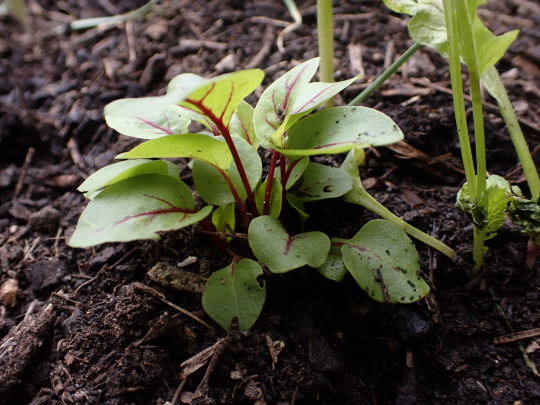
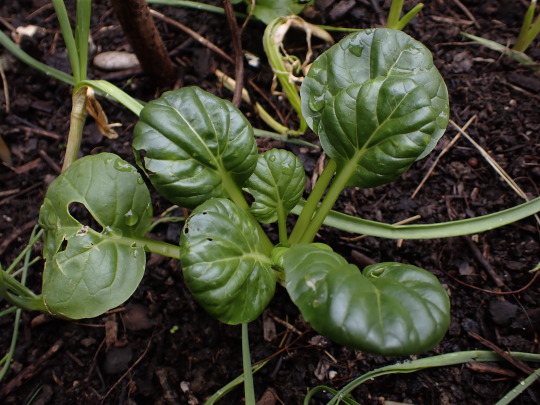




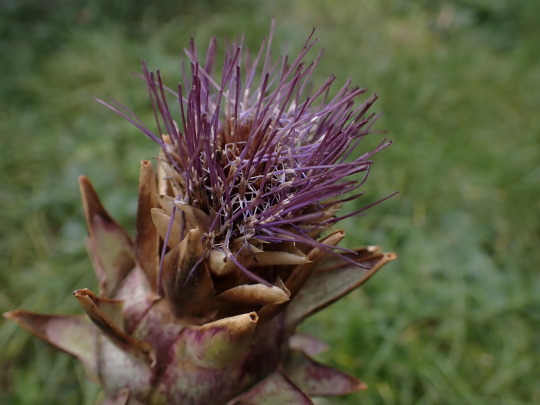
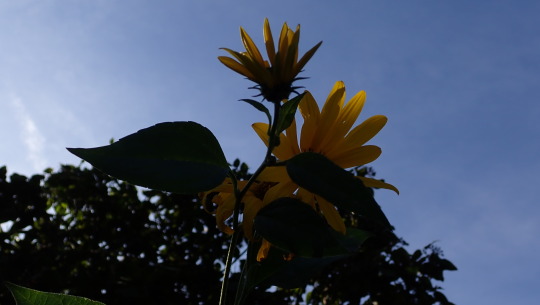

#pflücksalat#blutampfer#urban garden#schmelzgarten#wien#Rumex sanguineus#tatsoi#rosetten pak choi#pak choi#24.9.2023#ringelblume#Calendula officinalis#zitronenmelisse#Melissa officinalis#artischocke#Topinambur#Helianthus tuberosus#Mangold
0 notes
Text
La mélisse : comment l'utiliser en herboristerie ?
La mélisse est une plante connue pour ses propriétés digestives et relaxantes. On l’appelle parfois “citronnelle” ou “herbe au citron “en raison de son parfum très caractéristique. Dans cet article je vous en fais une petite description botanique. Je vous dis aussi quelques mots sur son histoire, sur la façon de la cultiver, de la récolter. enfin, je vous parle de ses propriétés médicinales et…

View On WordPress
0 notes
Text
"In response to last year’s record-breaking heat due to El Niño and impacts from climate change, Indigenous Zenù farmers in Colombia are trying to revive the cultivation of traditional climate-resilient seeds and agroecology systems.
One traditional farming system combines farming with fishing: locals fish during the rainy season when water levels are high, and farm during the dry season on the fertile soils left by the receding water.
Locals and ecologists say conflicts over land with surrounding plantation owners, cattle ranchers and mines are also worsening the impacts of the climate crisis.
To protect their land, the Zenù reserve, which is today surrounded by monoculture plantations, was in 2005 declared the first Colombian territory free from GMOs.
...
In the Zenù reserve, issues with the weather, climate or soil are spread by word of mouth between farmers, or on La Positiva 103.0, a community agroecology radio station. And what’s been on every farmer’s mind is last year’s record-breaking heat and droughts. Both of these were charged by the twin impacts of climate change and a newly developing El Niño, a naturally occurring warmer period that last occurred here in 2016, say climate scientists.
Experts from Colombia’s Institute of Hydrology, Meteorology and Environmental Studies say the impacts of El Niño will be felt in Colombia until April 2024, adding to farmers’ concerns. Other scientists forecast June to August may be even hotter than 2023, and the next five years could be the hottest on record. On Jan. 24, President Gustavo Petro said he will declare wildfires a natural disaster, following an increase in forest fires that scientists attribute to the effects of El Niño.
In the face of these changes, Zenù farmers are trying to revive traditional agricultural practices like ancestral seed conservation and a unique agroecology system.

Pictured: Remberto Gil’s house is surrounded by an agroforestry system where turkeys and other animals graze under fruit trees such as maracuyá (Passiflora edulis), papaya (Carica papaya) and banana (Musa acuminata colla). Medicinal herbs like toronjil (Melissa officinalis) and tres bolas (Leonotis nepetifolia), and bushes like ají (Capsicum baccatum), yam and frijol diablito (beans) are part of the undergrowth. Image by Monica Pelliccia for Mongabay.
“Climate change is scary due to the possibility of food scarcity,” says Rodrigo Hernandez, a local authority with the Santa Isabel community. “Our ancestral seeds offer a solution as more resistant to climate change.”
Based on their experience, farmers say their ancestral seed varieties are more resistant to high temperatures compared to the imported varieties and cultivars they currently use. These ancestral varieties have adapted to the region’s ecosystem and require less water, they tell Mongabay. According to a report by local organization Grupo Semillas and development foundation SWISSAID, indigenous corn varieties like blaquito are more resistant to the heat, cariaco tolerates drought easily, and negrito is very resistant to high temperatures.
The Zenù diet still incorporates the traditional diversity of seeds, plant varieties and animals they consume, though they too are threatened by climate change: from fish recipes made from bocachico (Prochilodus magdalenae), and reptiles like the babilla or spectacled caiman (Caiman crocodilus), to different corn varieties to prepare arepas (cornmeal cakes), liquor, cheeses and soups.
“The most important challenge we have now is to save ancient species and involve new generations in ancestral practice,” says Sonia Rocha Marquez, a professor of social sciences at Sinù University in the city of Montería.
...[Despite] land scarcity, Negrete says communities are developing important projects to protect their traditional food systems. Farmers and seed custodians, like Gil, are working with the Association of Organic Agriculture and Livestock Producers (ASPROAL) and their Communitarian Seed House (Casa Comunitaria de Semillas Criollas y Nativas)...

Pictured: Remberto Gil is a seed guardian and farmer who works at the Communitarian Seed House, where the ASPROL association stores 32 seeds of rare or almost extinct species. Image by Monica Pelliccia for Mongabay.
Located near Gil’s house, the seed bank hosts a rainbow of 12 corn varieties, from glistening black to blue to light pink to purple and even white. There are also jars of seeds for local varieties of beans, eggplants, pumpkins and aromatic herbs, some stored in refrigerators. All are ancient varieties shared between local families.
Outside the seed bank is a terrace where chickens and turkeys graze under an agroforestry system for farmers to emulate: local varieties of passion fruit, papaya and banana trees grow above bushes of ají peppers and beans. Traditional medicinal herbs like toronjil or lemon balm (Melissa officinalis) form part of the undergrowth.
Today, 25 families are involved in sharing, storing and commercializing the seeds of 32 rare or almost-extinct varieties.
“When I was a kid, my father brought me to the farm to participate in recovering the land,” says Nilvadys Arrieta, 56, a farmer member of ASPROAL. “Now, I still act with the same collective thinking that moves what we are doing.”
“Working together helps us to save, share more seeds, and sell at fair price [while] avoiding intermediaries and increasing families’ incomes,” Gil says. “Last year, we sold 8 million seeds to organic restaurants in Bogotà and Medellín.”
So far, the 80% of the farmers families living in the Zenù reserve participate in both the agroecology and seed revival projects, he adds."
-via Mongabay, February 6, 2024
#indigenous#ecology#agroforestry#agriculture#traditional food systems#traditional medicine#sustainable agriculture#zenu#indigenous peoples#farming#colombia#indigenous land#traditional knowledge#seeds#corn#sustainability#botany#plant biology#good news#hope#climate action#climate change#climate resilience#agroecology#food sovereignty
1K notes
·
View notes
Text
herbal teas guide —
🌿🍃 having conversations with my mutuals all over the world, i was stunned to find out that not every country/culture practices drinking herbal teas for health issues. as a slavic person i decided to create this little guide because – and i'm saying this as a skeptical person who hates superstitions – they really work. 🍃🌿
mint tea (mentha piperita) is for digestion and relaxation chamomile tea (matricaria chamomilla) is for digestive system horsetail tea (equisetum arvense) is for skin, hair, nails condition, remineralization and circulatory system linden tea (tilia cordata) is for a cold lemon balm tea (melissa officinalis) is for relaxation and sleep nettle tea (uritca dioica) is for urinary tract sage tea (salvia officinalis) is for when your throat or teeth hurt fennel tea (funiculum vulgare) is for digestive system white mulberry tea (morus alba) is for carbohydrate metabolism pansy tea (viola tricolor) is for clean skin and body detox purge tea (cistus incanus) is for immunity hawthorn tea (crataegus monogyna) is for heart and circulatory system damian leaves tea (turnera diffusa) is for anxiety and libido dandelion tea (taraxacum officinale) is for liver, stomach and digestion st john's wort tea (hypericum perforatum) is for emotional balance, good mood, digestive system and kidney function
🌿🍃 to create this guide i was using a booklet from my pharmacy store. if you google them, you will find out that each of these have even more usage methods than the ones listed. 🍃🌿
🌿🍃 if you're from a different country/culture and you know more herbal teas like these, feel free to add them. 🍃🌿
#felt extra this evening but ive been planning to make it for a few weeks now#posted by me#slavic#polish#poland#herbs#herbal#organic#health and wellness#tea#guide
236 notes
·
View notes
Text
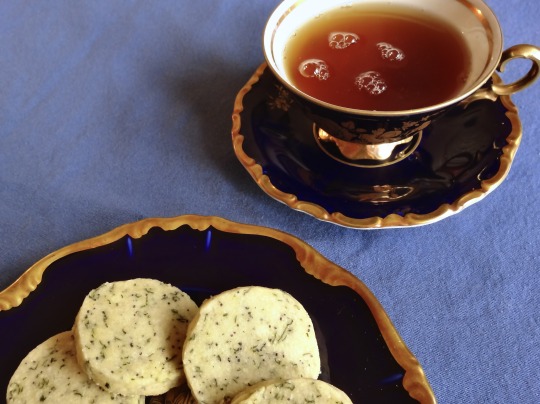
Lemon balm shortbread cookies
Lemon balm (Melissa officinalis), a commonly foraged plant in the mint family, gives a lightly herbacious, bright lemon flavor to these shortbread cookies. They have a classic, crisp, sandy shortbread texture; optional poppy seeds add crunch and a mild nutty flavor. The lemon balm and poppy seeds may be swapped out for any combination of herbs, spices, or citrus zest that your heart desires.
These cookies are subtly sweet and very dunkable, making them perfect companions to a cup of tea or coffee.
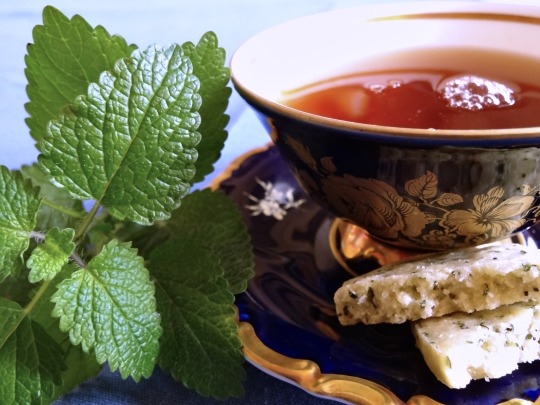
Recipe under the cut!
Patreon | Paypal | Venmo
Lemon balm has square stems and opposite leaves (two leaves per node on opposite sides of the stem). Leaves are simple (one leaf blade with no leaflets); ovate and slightly heart-shaped, with scalloped edges; slightly glossy; thin, soft, and hairy; and deeply veined. They are emerald green on the top, and a lighter greyish green on the underside. They have a lemony scent and an oily texture when crushed. Stems and petioles (leaf stalks) are covered in small standing hairs.
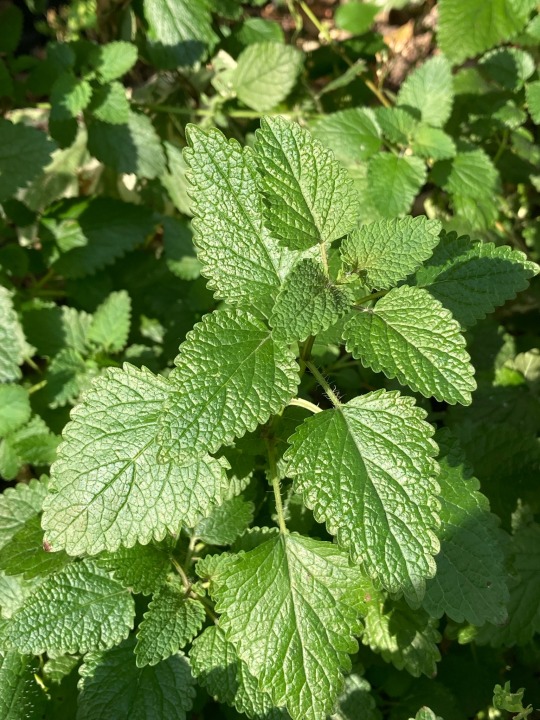
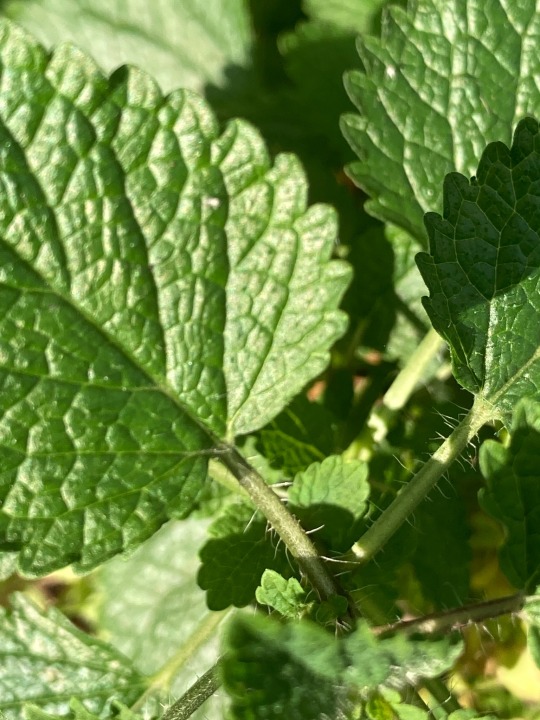
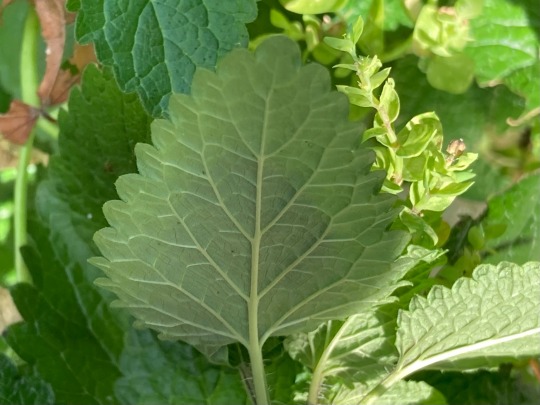
Ingredients:
120g (1/2 cup + 1 Tbsp) salted non-dairy margarine, softened
60g (1/3 cup) caster or granulated sugar
180g (1 1/2 cups) AP flour
1/4 cup (8.5g) minced lemon balm
1 tsp poppy seeds (optional)
Like most traditional shortbread, this recipe follows a 1:2:3 ratio of sugar:butter:flour (by weight). Any herbs, spices, citrus zest, etc. of your choosing may be added to that base.
You could replace the caster sugar with powdered sugar if you want a melt-in-your-mouth texture, rather than a typical crumbly shortbread texture.
Instructions:
Cream margarine with an electric beater for 30 seconds, until it has a whipped texture. Add lemon balm and sugar and beat for another 3 minutes or so, until a couple shades lighter in color (this means that you have incorporated enough air).
Add the flour and mix well with a wooden spoon; then press with your hands to form into a ball.
Roll the dough out into a cylinder. You can make the cylinder more regular by placing it on a piece of wax or parchment paper, then folding the parchment paper over; use a ruler or the flat of a knife to force the cylinder of dough back into the folded edge of the paper.
Wrap the dough by twisting the ends of the parchment paper around, like a candy wrapper. Chill the dough for at least an hour, to keep the cookies from spreading in the oven by allowing the flour to absorb liquid.
Using a sharp paring knife, cut the cylinder of dough into slices about 1/4" thick. Place on a baking sheet lined with parchment paper, about 1/2" apart.
Bake at 350 °F (180 °C), in the top third of your oven, for 8 to 10 minutes. For chewier cookies, bake just until the center of the top and bottom of the cookie is no longer wet-looking; for crisper ones, bake until the edges are just starting to turn a light golden color.
109 notes
·
View notes
Text
Kitchen Witchery: Elminx's Anti-anxietea

In honor of eclipse season, I wanted to share a recipe to bring your buzz down a notch (or two). I've been drinking this nervine tea for nearly five years now; it features all of my favorite herbal flavors! I'm not going to go into detailed herbal profiles for each of these botanicals, but I suggest looking into them more if you are curious. I think learning the basics of herbalism can greatly benefit the kitchen witch.
Each of these ingredients can be found in any decent grocery store, bought online, or grown yourself. The combination is designed with flavor and herbal actions in mind; it's not a measure of exact ingredients - mix with your heart. All of these botanicals are well tolerated and can be drunk regularly by most people. Please be careful when trying new herbs; allergic or other adverse reactions can occur.

Hibiscus, Hibiscus sabdariffa Hibiscus is the primary flavoring agent in this blend. It gives our tea its Cool, Moist, and Sour properties. Please keep in mind that hibiscus will stain anything it comes into contact with, including clothing, wooden spoons, and even countertops. If you don't think you're familiar with hibiscus, it is the primary flavor in all "Zinger" teas. It tastes tart and inexplicably red.
Peppermint, Mentha piperito
Peppermint is the first of our gentle nervines to be added to our tea. Nervines do exactly what you expect them to: they calm your nerves. In addition to being a nervine (primary benefit), Peppermint adds its properties of Pungent, Sweet, Cool, Warm, and Dry to our tea. I'm sure you're all familiar with peppermint; you could probably substitute a different mint here with similar effect.
Lemon Balm, Melissa officinalis
Lemon balm is a nervine and a mild sedative. It brings the properties of Sour, Cool, and Dry to our tea. Some people don't like the taste of lemon balm, saying that it tastes like Pledge. If that's you, just omit it from this drink. The taste of hibiscus strongly overpowers the lemon balm, though, so maybe try it first.
Tulsi (Holy Basil), Ocimun santum
Tulsi is a nervine and adaptogenic herb, which means that it helps the body manage stress better. Its properties are Pungent, Sweet, Bitter, and Warm. With its heady, peppery notes, Tulsi is certainly an acquired flavor. If you get along with this herb, you will know almost immediately upon drinking it for the first time. A little goes a long way; you don't need to overdo it.
Dried Apple, Malus sp.
Although apple is primarily a flavoring agent (and sometimes a sweetening agent) in this blend, it does have mild sedative effects that lend themselves to the overall feel of this tea. I suggest using the apples you would eat in this recipe; you can dry slices of apples by putting them in your oven at 225F for 1.5 to 2 hours. Use a sweeter apple if you want a sweeter tea.

Minx's Anti-Anxietea
2 parts hibiscus
1 part peppermint
1 part lemon balm
1-2 parts dried apple
.5 part tulsi
Start by adding 1 tsp tea to hot water and steeping for 8 minutes. Adjust to your tastes from there.
This drink tastes great, hot or cold.
I've never sweetened this tea because I like my drinks bitter like my soul, but I bet a dollop of honey would be lovely in this—especially a nice summery wildflower honey. I've added sweetened cranberries in the past (1-2 parts) for more sweetness. And honestly, I don't measure. I know when it smells right.
I apply this drink liberally, but some people may find it too strong a diuretic to consume more than once daily. I drink it any time that I feel especially anxious or when I know I am going to be under a lot of stress. My partner likes to drink it before bedtime and claims it's one of the only things that will calm them down when they feel like they have too many thoughts.
You can witch this up (it's a verb now!) as little or as much as you like. I like to work calming energy into the drink step by step as I create the mixture by working with each botanical individually. You could charge this with a candle or sigil, dedicate it to one of your favorite gods or spirits, or store it on your altar. I create bindrunes for my favorite tea blends and use them as magical labels.
Do you like my work? You can tip me over on Kofi or sign up to be a monthly supporter of my writing.
36 notes
·
View notes
Text

#g#infographic#herbarium#lemon balm#Melissa officinalis#mint family#herbs#herbalism#food centric herbalism#herbal medicine#botanicals#botanyculture#sidewalkchemistry
2 notes
·
View notes
Text
Moth of the Week
Mint Moth
Pyrausta aurata

[Right | Left]
The mint moth is a part of the family Crambidae, the grass moth family. It was first described in 1763 by Giovanni Antonio Scopoli (sometimes Latinized to Johannes Antonius Scopolius).
Description This moth has purple-brown forewings with yellow marks. The marks on the wings varies but is usually one yellow spot near the middle of the wing but leaning closer to the costa (top edge/vein of the wing). It is also common to have smaller yellow marks with the larger spot. It is possible for the forewing to be blank. It is also possible to have yellow markings that look like a wavy band on the forewings. The hindwings are a dark brown or black with a yellow band in the center.
Wingspan: 1.8 - 2 cm (0.71 - 0.79 in).
The caterpillar of this moth ranges from light green, dark green, light brown, black gray and reddish with a darker back line. They also have a dark brown head.
Length: 13 cm (≈0.512)
Diet and Habitat This species most often eats mint (Mentha spicata and Mentha rotundifolia) but also eats plants like marjoram, Salvia pratensis, Melissa officinalis, Nepeta cataria and Calamintha species.
This species is widely distributed in Europe, North Africa, and North Asia. It reaches to Siberia, North China, Korea, and Japan in the east and to Asia Minor, the Middle East, Iran, Afghanistan, Middle Asia and Mongolia in the south. They inhabit chalk and limestone grassland, woodland, marshland, quarries, places with waterside vegetation, and gardens
Mating This moth has two generations a year in north-west Europe. It flies from April until the end of September. Specifically in the UK, it breeds from May to June then from July to August.
Predators This species flies during the day and at night. No listed protections or specific predators.
Fun Fact The mint moth (Pyrausta aurata) can be mistaken for Pyrausta purpuralis as they are related. However, Pyrausta purpuralis is larger and has a more distinct band on the forewing. This band is usually divided in 3.
(Source: Wikipedia [1][2], Butterfly Conservation)
#libraryofmoths#animals#bugs#facts#insects#moth#lepidoptera#mothoftheweek#crambidae#mint moth#Pyrausta aurata#small purple and gold moth#tw bugs
38 notes
·
View notes
Text

Litha, Summer Solstice, Midsummer – circa June 22
Litha 2024: A Witches Guide to the Pagan Summer Solstice Celebration
Litha, also known as the Summer Solstice, is a pagan holiday celebrated on or around June 21st in the Northern Hemisphere. It is the longest day and shortest night of the year, and marks the official start of summer. Litha stands as one of the four 'lesser sabbats,' marking the pinnacle of the solar calendar. In pagan traditions, it is a time to celebrate the power of the sun and the abundance and growth of the natural world. It is also seen as a time of balance between light and dark, and a turning point in the year when the days begin to grow shorter and the nights longer. This holiday is a time of abundance, growth, and light, and is associated with a variety of correspondences, including colours, crystals, deities, traditions, and ways to observe the holiday.
When is Litha 2024
Litha celebration will land on June 20, 2024 in the Northern Hemisphere. In the Southern Hemisphere, Litha, or the summer solstice, occurs around December 21st or 22nd. This is when the Southern Hemisphere experiences the longest day and the shortest night of the year, marking the official beginning of summer.
How to Pronounce Litha
Litha pronunciation is "LEE-thuh" with the emphasis on the first syllable. The word "Litha" is believed to have originated from the Anglo-Saxon word for "midsummer" and is still used by modern pagans and Wiccans to refer to this holiday.
Litha Meaning
As a spiritual holiday, Litha is a time for rituals and ceremonies that honour the sun and the energy of the summer season. It is a time to connect with the natural world and to celebrate the beauty and diversity of life. It is also a time to reflect on personal growth and to set intentions for the rest of the year.
Overall, the meaning of Litha is one of joy, abundance, and connection to the natural world. It is a time to celebrate the light and warmth of the sun, and to embrace the energy of growth and transformation that comes with the summer season.
Litha Colours
The colours typically associated with Litha include yellow, gold, green, and blue. Yellow and gold represent the sun, which is at its strongest and brightest during this time of year. Green represents growth and abundance, while blue represents the sky and the waters of life.
Litha Herbs
Litha, or the summer solstice, is associated with a variety of herbs that symbolize the energy, growth, and warmth of the season. Here are some herbs commonly associated with Litha:
St. John's Wort (Hypericum perforatum): This herb is often associated with the summer solstice and is believed to have protective and healing properties. It's in full bloom around this time.
Lavender (Lavandula spp.): Known for its calming and soothing properties, lavender is often used during Litha rituals to promote relaxation and spiritual connection.
Mugwort (Artemisia vulgaris): Mugwort is associated with psychic awareness and protection. It's sometimes used in divination practices during Litha.
Chamomile (Matricaria chamomilla): Chamomile is known for its calming properties and is often associated with relaxation, making it suitable for Litha rituals focused on introspection and meditation.
Rose (Rosa spp.): Roses are symbols of love and passion and are often associated with the sun. They can be used in rituals or as decorations to bring beauty and positive energy.
Lemon Balm (Melissa officinalis): Lemon balm is associated with the sun and is believed to attract love and positive energy. It has a refreshing and uplifting scent.
Mint (Mentha spp.): Mint is often associated with prosperity and vitality. It can be used in rituals to bring abundance and refresh the energy.
Sage (Salvia officinalis): Sage is known for its cleansing properties. It can be used to purify a space before Litha rituals or celebrations.
Yarrow (Achillea millefolium): Yarrow is associated with courage and protection. It's often used in rituals to enhance personal strength and resilience.
Calendula (Calendula officinalis): Calendula, with its vibrant yellow and orange petals, is associated with the sun and is often used in rituals for joy and positive energy.
These herbs can be used in various ways during Litha, such as in incense, sachets, wreaths, or as offerings in rituals.
Flowers for Litha
Flowers are an important part of the Litha celebration. You can use them to decorate your altar, make flower crowns, or simply enjoy their beauty as a reminder of the abundance and growth of the summer season. Some flowers that are commonly associated with Litha and the summer solstice include:
Sunflowers: These vibrant flowers are often associated with the sun and the power of light.
Roses: With their beautiful blooms and sweet fragrance, roses are a symbol of love, beauty, and passion.
Lavender: This fragrant herb is often associated with relaxation, purification, and healing.
Marigolds: These bright orange and yellow flowers are often used in rituals to honour the sun and the power of fire.
Daisies: These simple yet cheerful flowers are a symbol of innocence, purity, and new beginnings.
Chamomile: This delicate flower is often used in rituals to promote calmness, relaxation, and restful sleep.
Yarrow: This herb is often associated with courage, strength, and protection.
Crystals:
Many crystals are associated with Litha, including citrine, sunstone, tiger's eye, and amber. These stones are said to bring warmth, abundance, and vitality, and can be used in a variety of ways during Litha rituals and celebrations.
Deities:
There are a variety of deities associated with Litha, depending on your spiritual tradition. Some popular options include the goddesses Brigid, Gaia, and Freyja, as well as the gods Lugh, Apollo, and Helios. These deities are often associated with the sun, fire, and growth, and can be called upon to bring blessings and abundance during Litha celebrations.
Litha Tarot Cards
While there isn't a specific set of tarot cards exclusively associated with Litha, the themes and energies of the summer solstice can be reflected in certain cards. Here are some tarot cards that might resonate with the themes of Litha:
The Sun (XIX): The Sun card is one of the most direct associations with the energy of Litha. It represents positivity, success, and the height of vitality. It signifies the triumph of light over darkness.
The Emperor (IV): The Emperor card is associated with structure, order, and leadership. It can symbolize the power of the sun in providing stability and guidance during the height of summer.
The Empress (III): The Empress represents fertility, abundance, and growth. It is a card that aligns well with the themes of the summer season when nature is flourishing.
The Wheel of Fortune (X): This card represents cycles and the turning of the seasons. It can symbolize the natural order of life and the changes that come with each season, including the transition from spring to summer.
The Ace of Wands: Wands in the tarot often represent fire and energy. The Ace of Wands, in particular, signifies new beginnings, inspiration, and the spark of creativity—qualities associated with the active and vibrant energy of summer.
The Nine of Cups: Known as the "Wish Card" or "Happiness Card," the Nine of Cups represents emotional fulfillment and contentment. It can be seen as a card of celebration, aligning well with the joyous atmosphere of Litha.
The Lovers (VI): The Lovers card represents harmony, unity, and the coming together of opposites. It can be interpreted as a card of balance and connection, reflecting the balance of light and darkness during the summer solstice.
The Four of Wands: This card is often associated with celebrations, achievements, and a sense of community. It can represent the joyous gatherings and festivities that often accompany the summer season.
Remember, tarot is a highly personal and intuitive practice. Feel free to choose cards that resonate with you and the specific aspects of Litha that you wish to focus on in your readings and rituals.
Traditions:
There are many different ways to observe Litha, depending on your personal beliefs and traditions. Some common practices include:
Lighting bonfires or candles to celebrate the light and warmth of the sun
Decorating altars and sacred spaces with flowers, herbs, and other symbols of growth and vitality
Holding outdoor rituals or gatherings to connect with nature and honour the turning of the seasons
Creating and sharing meals made with fresh, seasonal ingredients
Participating in activities that celebrate creativity, such as dancing, singing, or making art. Witches' Sabbath Zakuro Aoyama
31 notes
·
View notes
Text
So I reading more scientific articles on herbs, this time looking at lemon balm and it's anti-depressant/anti-anxiety/anti-insomnia effects, and it's really interesting what you find, like this case study:
Does Melissa Officinalis Cause Withdrawal or Dependence?
"A 30-year-old married male, a university graduate, applied to the emergency department with complaints of restlessness, tremor, distractibility, and sweating that had lasted approximately 24 hours. His medical history revealed that he was in the stressful period and had been suffering from anxiety symptoms for three months. He had purchased melissa tea (including Melissa officinalis) from an herbalist two months prior in order to help treat his anxiety symptoms. He drank it regularly at night without combining it with another plant-based tea. He stated that he felt relief from anxiety after drinking the tea and felt restless and irritable when he did not consume the tea. Further, over the course of two months, the amount of tea he consumed increased from one cup per day to four cups per day. His symptoms began 24 hours before being admitted to the emergency department, and he did not drink any tea for the two days prior. On psychiatric examination, he exhibited open conscious, normal orientation, anxious mood, internal restlessness, irritability, and reported decreased sleep, appetite, and concentration. He also experienced an increasingly strong craving for melissa tea. The patient had no history of major medical or mental illness and had no documented alcohol or drug use."
Now after that, I read a few papers that actually looked at its usefulness as an anti-depressant, and my take away is that if you're going to use an herb as a replacement for a prescription medication, give it the same respect, and don't ramp up your use and then stop it or prescription depression/anxiety medications cold turkey, or you're going to have a bad time.
26 notes
·
View notes
Text
'Did you know..?"
A/N: A request/suggestion by the ever-lovely @beardedladyqueen! While Regis isn't really my thing personally I'm always more than happy to experiment with characters and see what makes people happy! I also realized while writing this that I... I'm just Reigs. I'm an herbalist who just loves to tell people fun facts and maybe falls a little in love when people use scientific names.
Pairing: Regis x Reader
Words: 727
____________________
Birds tweeted eloquently from above, their feather-light songs bouncing off each other and stitching themselves into a fantastic melody. The wind rustled through the delicate grass, tickling your arms as you cut another leaf off the little plant. The large umbrella of shade trees above provided a welcome respite from the wicked heat of the day as well as a comforting sense of protection as it watched over your dutiful work.
“Alright, thank you little plant, that's all…” you said with a quick smile as you stood back up and placed your fistful of leaves into an empty jar. Quietly your feet padded around the well-worn protrusions- headstones dappling the surrounding landscape- as you look for your next plant. Your fingers brushed against a particularly moss-covered wall as you made your way around a moss-covered mausoleum when you were nearly scared out of your own skin.
“Aah!” you exclaimed, jumping about a foot in the hair, your hands immediately clutching your chest as you spotted him, “oh- ah, wow… I’m terribly sorry, I didn’t know anybody else was here..” you explained as you looked over at the figure sitting before a long-gone campfire. He had dark gray hair pushed back and away from his face, matching sideburns that emphasized already prominent cheekbones, and tired eyes that you’re sure made him look far older than he really was. But you found it all rather endearing, he looked as if he spends all night carrying the weight of the world on his shoulders, yet still seemed to hold the sunniest disposition.
“Oh, that’s quite alright.” the older man said, standing up from his fire to turn to you. “I wasn’t aware anyone frequented this area- oh, forgive my manners” he held his hand out to you, “I’m Regis… “ he said as he shook your hand.
You introduced yourself in turn with a gentle smile and a shake of his hand. “It's been a while since I've foraged here if I’m being honest, so I doubt I could lay much claim to it.”
“Hmm, is that lily of the valley and… do I smell lemon balm?” The vampire inquired with curious excitement as your hands came close, now peeking over to look toward your herb-laden basket.
You chuckled with surprise and showed him your collection, “What an amazing nose you have..! Yes, I just gathered some before I came around the corner.”
Regis's lips pulled into a sheepish smile, knowing he was perhaps being a little too telling with his vampiric talents than he would have liked, “yes, well I-I think the scent must still be on your hands,” he said, straightening his posture a bit more, “I actually dabble a bit into herbalism as well… did you know that lemon balm can be used for anxiety, appetite, and even-”
“-Insomnia,” you two said in unison, causing you both to pause before easy laughter filled the otherwise lonesome cemetery.
You grinned brightly as you shook your head, “Yes, actually that's what I’m gathering it for… I’ve been having absolutely dreadful sleep lately and was hoping Miss Melissa officinalis could help me out a bit with that”, you said with the slightest tinge of blush- no one ever wanted to talk plants with you before. Usually, people just listened for a bit to amuse you, but rarely did they ever want to bring it up again. Yet here this older man stood before you with an almost giddy smile that was barely hidden behind a veil of well-mannered resignation.
Regis on the other hand thought his immortal heart might just burst out of his chest and onto the floor, then and there. A fellow herbal enthusiast and you can drop a scientific name into conversation like it's nothing? He couldn’t remember the last time he had smiled so broadly at something so seemingly small.
“I- please, forgive me if this is too forward,” Regis started, nearly tripping over his seat as he stepped forward. He knew it was terribly unlike himself to be so clumsy, but for some reason, he just couldn’t seem to help it. “but would you mind if I accompanied you while you continue to forage?”
Your shy but determined smile captivated him like the first glimpse of morning light as you held your basket out to the love-struck vampire.
“Only if you promise to carry the basket.”
__________
Taglist: @writingmysanity @open--till--midnight @madamemelancholysstuff @dark-academia-slut
Want to be on a Taglist? Did my brain slip and I forgot to tag you? DM me to let me know!
#Regis is a BIG OL NERD AND SO AM I#Emiel Regis imagine#Regis imagine#Regis X Reader#Regis x You#Emiel Regis x You#Regis x Y/n#Emiel Regis x Reader#Emiel Regis x Y/n#The witcher Self insert#witcher self insert
72 notes
·
View notes
Text
I cyclically apologise for disappearing, but I really really really needed this time off 🏔️

I’m currently here! The view is always amazing and the weather is even better these days 🌞

Some wild strawberries 🍓 they’re supposed to be ripe in June but these were already red (guess who devoured them….)




Also some Primroses that I thought were mandrake fruits!! I was so excited but the leaves weren’t quite mandrake-like, researching I found out that they were actually primroses… also some more Hellebore foetidus and Melissa officinalis. Last but not least some Salvia pratensis’ flowers of which I love their vibrant violet color 💜
#witch#pagan#nature#witchy#witchcraft#traditional witchcraft#witchblr#green witch#green witchcraft#nature photography#botanical#wild#personal#magic#magick
9 notes
·
View notes
Text

Herbs of The Moon
Herbs For The Moon Phases
New Moon Herbs: Angelica (Angelica archangelica), Basil (Ocimum spp.), Elder (Sambucus nigra), Lavender (Lavandula officinalis), Milky Oat (Avena sativa), Peppermint (Mentha piperita), Sage (Salvia officinalis).
Mugwort (Artemisia vulgaris or your local variety) is considered a Moon herb for all phases.
Full Moon Herbs: Lavender (Lavandula officinalis), Lemon Balm (Melissa officinalis), Meadowsweet (Filipendula ulmaria), Milky Oat (Avena sativa), Motherwort (Leonurus cardiaca), Mugwort (Artemisa vulgaris), Passionflower (Passiflora incarnata), Peppermint (Mentha piperita), Plantain (Plantago major), Sage (Salvia officinalis), Self-Heal (Prunella vulgaris).
Dark Moon Herbs: Elder (Sambucus nigra), Hawthorn (Crataegus monogyna), Lavender (Lavandula officinalis), Mugwort (Artemisia vulgaris), Nettles (Urtica dioica), Passionflower (Passiflora incarnata), Sage (Salvia officinalis), Yarrow (Achillea millefolium).
General Moon Herbs
Lemon balm (Melissa officinalis)
Jasmine (Jasminum spp.)
Lavender (Lavandula spp.)
Mugwort (Artemisia vulgaris)
Evening primrose (Oenothera biennis)
Clary Sage (Salvia sclarea)
Nutmeg (Myristica fragrans)
Blue Vervain (Verbena hastata)
California Poppy (Eschscholzia californica)
#herbs#moon#paganblr#paganism#pagan#witch#witches#witchblr#witchcraft#new moon#dark moon#full moon#spellwork#spellcraft#magick#grimoire#bomresources
2 notes
·
View notes
Text




Flowers and herbs (2) (3) (4) by Miroslav Kravec
Via Flickr:
(1) Wild carrot (2) (3) Lemon balm / Melissa officinalis (4) Sambucus nigra after the rain
5 notes
·
View notes